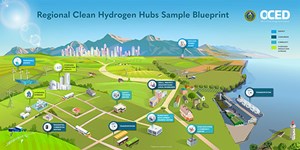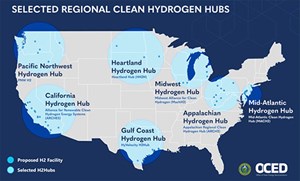Articles
Transforming the U.S. into a widespread H2 hub
Editorial Comment
T. CAMPBELL, Managing Editor
In October 2023, the Biden-Harris Administration and the U.S. Department of Energy (DOE) announced $7 B in investments to launch seven nationwide Regional Clean Hydrogen Hubs (H2Hubs) throughout the country. This is part of President Biden’s Investing in America agenda, an attempt to reinvigorate the U.S. economy by bringing manufacturing back to America and prioritizing the commercial deployment of low-cost, clean hydrogen (H2). The H2Hubs are projected to produce approximately 3 MM metric tpy of H2, significantly contributing to the U.S.’s 2030 H2 production and carbon dioxide (CO2) reduction targets (FIG. 1). According to the DOE, the hubs were selected depending on five main factors:
- Technical merit and impact: The hub must produce 50 metric tpd–100 metric tpd of clean (green) H2
- Financial and market viability: Scalability and market competitiveness
- Workplan: When the hub is projected to be operational
- Management team and project partners: The team’s competency in successfully completing large-scale projects
- Community benefits: Quality job creation, diversity, equity and inclusion.
The seven H2Hubs will be scattered across different U.S. regions, including the Pacific Northwest, California, the Gulf Coast, Heartland, Midwest, Appalachian and Mid-Atlantic regions (FIG. 2). The Pacific Northwest H2 hub (PNW H2) will be located across Washington, Oregon and Montana, solely utilizing renewable energy to produce green H2 through electrolysis and potentially reducing CO2 emissions by 1 MM metric tpy.
The prime contractor is the Pacific Northwest Hydrogen Association, which includes Air Liquide Hydrogen Energy US LLC, Amazon.com Inc., ALA Renewable Energy LLC, Atlas Agro, Centralia College, Mitsubishi Power Americas Inc., Northwest Seaport Alliance NovoHydrogen Development Inc., PACCAR Inc., Portland General Electric Co. (PGE), Puget Sound Energy (PSE), PUD No. 1 of Douglas County, St. Regis Solar LLC, Synchronous LLC dba First Mode, Twin Transit, USA Fortescue Future Industries Inc. and Williams Field Services Group LLC, and the federal cost share is up to $1 B.
The California H2 hub will span the state, producing H2 from renewables and biomass, eventually aiming to pave the way to decarbonizing heavy-duty transportation and converting ports to export H2. Furthermore, the hub aims to cut CO2 emissions by 2 MM metric tpy. The prime contractor for the project is the Alliance for Renewable Clean Hydrogen Energy Systems (ARCHES), a statewide public-private partnership designed to accelerate renewable H2’s contribution to decarbonizing California’s economy, and the federal cost share is up to $1.2 B.
The Gulf Coast H2 hub will be spread across the Texas coast, producing H2 via natural gas coupled with carbon capture and electrolysis. This hub will also integrate salt caverns to store H2 and H2 pipelines for transport. The Gulf Coast H2 hub is projected to reduce CO2 emissions by approximately 7 MM metric tpy. The prime contractor for this hub is HyVelocity, an industry-led H2 hub that includes seven core industry partners: AES Corp., Air Liquide, Chevron, ExxonMobil, Mitsubishi Power Americas, Ørsted and Sempra Infrastructure. The federal cost share is up to $1.2 B.
The Heartland H2 hub will be located across Minnesota, North Dakota and South Dakota to produce clean fertilizers, such as ammonia, and reduce green H2 production costs. Furthermore, the region will explore utilizing H2 for power generation. The Heartland H2 hub is projected to reduce CO2 emissions by 1 MM metric tpy. The prime contractor for this project is the Energy and Environmental Research Center (EERC), and the federal cost share is up to $925 MM.
The Midwest H2 hub will be in Illinois, Indiana and Michigan, decarbonizing sectors such as steel and gas production, power generation and aviation, utilizing renewables, natural gas and nuclear energy. The hub aims to reduce CO2 emissions by 3.9 MM metric tpy. The prime contractor for this hub is MachH2, and the federal cost share is up to $1 B. Notable partners in this alliance include Air Liquide, ArcelorMittal, Argonne National Laboratory, Bloom Energy, bp, Charbone Hydrogen, ExxonMobil, Gevo, Nalco Water, Plug Power and Rockwell Automation.
The Appalachian H2 hub will be in West Virginia, Ohio and Pennsylvania, and plans to leverage natural gas coupled with carbon capture to produce blue H2. The hub aims to reduce CO2 emissions by 9 MM metric tpy. The prime contractor for this hub is Battelle, and the federal cost share is up to $925 MM.
The Mid-Atlantic H2 hub will be in Pennsylvania, Delaware and New Jersey, seeking to utilize renewables and nuclear electricity to decarbonize heavy-duty transportation, industrial process improvements and combined heat and power. The hub anticipates reducing CO2 emissions by 1 MM metric tpy. The prime contractor for this hub is the Mid-Atlantic Clean Hydrogen Hub (MACH2), and the federal cost share is up to $750 MM. Notable MACH2 partners include Air Liquide, Bloom Energy, Braskem, Dupont, Enbridge, Hilco and PBF Energy.
If successful, these H2 hubs have the potential to substantially ramp up clean H2 production in the U.S. Coupled with the government’s investments to advance H2 production technologies (e.g., electrolyzers), the $1/kg in a decade milestone set by the DOE may be in reach.H2T



